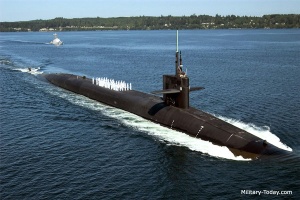 The U.S. could save $16 billion by downsizing the strategic submarine fleet from 12 to 8 and still deploy a New START-size force.
The U.S. could save $16 billion by downsizing the strategic submarine fleet from 12 to 8 and still deploy a New START-size force.
By Tom Z. Collina Defense Secretary Chuck Hagel warned this week that "tough, tough choices are coming" if the Pentagon is forced to make deep spending cuts, as required by law. Options on the table include slashing 20,000 to 30,000 soldiers and retiring an aircraft carrier. But, so far, the Pentagon says it is not considering options for reducing the high cost of nuclear modernization programs. It should. The United States can stay at warhead levels set by the 2010 New START treaty and still save billions by scaling back and delaying new delivery systems. The United States is planning to spend at least $355 billion on nuclear weapons over the next decade, much of that to rebuild the nuclear arsenal, according to the nonpartisan Congressional Budget Office (CBO). The Pentagon's proposed budget for fiscal year 2015, released March 4, would "preserve all three legs of the nuclear triad," Secretary Hagel said, and includes hefty down payments of $1.3 billion for a new fleet of 12 nuclear-armed submarines, which would cost about $100 billion to produce; $914 million for up to 100 new long-range bomber, which would cost up to $81 billion; and smaller amounts for land-based missiles and a new cruise missile. However, the defense budget still needs to be cut by $115 billion from 2016-2019 to meet sequester targets, or about $29 billion per year on average. And as much as Secretary Hagel wants Congress to change the law, that is not likely. Rep. Buck McKeon (R-Calif.), chairman of the Armed Services Committee, said this week that, "I don't see any way that [sequester] is going away right now." He added, "It's the law, and we're stuck with it." Rather than ignore these budgetary realities, the Pentagon could think outside the box by planning to deploy the number of warheads allowed by New START, but not as many delivery platforms, which are exorbitantly expensive to replace. For example, the United States could deploy up to 1,550 strategic warheads (the New START limit) until it decides to go lower under a future agreement or otherwise. To save money, the Pentagon could take two prudent steps: First, reduce the number of planned delivery vehicles. New START allows both sides to field up to 700 long-range delivery vehicles. By planning to field 600 or less, the United States would save billions. For example, the Pentagon plans to deploy about 1,000 warheads at sea under New START. It does not take 12 submarines to do that; eight is enough. This option would save $16 billion over the next decade and an additional $30 billion during the 2030s by avoiding the purchase of four subs, according to CBO. In the highly unlikely event that additional submarines are needed later, they could be added back into the budget. Russia is already well below New START limits. Other than Russia, the only potential U.S. adversary with a long-range nuclear capability is China, which has no more than 75 single-warhead intercontinental ballistic missiles, according to the Pentagon. Second, the Pentagon could delay production of new delivery systems until they are really needed. If the Pentagon can delay procurement decisions on major systems until future needs are clearer, it would likely need fewer of them. For example, the Air Force's new bomber program can be delayed until the mid 2020s, saving $32 billion over 10 years, according to CBO. Even with a 10-year delay, a new bomber would still be ready by the time current bombers are reaching the end of their service life, and the delay would allow the new bomber to incorporate technological advances made during that time. To its credit, the Air Force has already taken a step in the right direction by delaying a new nuclear-armed cruise missile by three years, pushing almost $1 billion in spending beyond 2018. This two-step plan is a prudent alternative to the current approach, which will likely lead the United States to buy more nuclear weapons than it needs, sooner than it might need them. This proposal is supported by two bills recently introduced in Congress by Sens. Edward Markey (D-Mass.) and Jeff Merkley (D-Ore.), and by Rep. Earl Blumenauer (D. Ore.), which call for reduced nuclear spending. This common sense approach would allow the United States to maintain New START warhead levels and save money on new nuclear delivery systems, freeing up resources for higher priorities over the next decade. Even at a time of heightened U.S.-Russian tensions, Washington can save money on nuclear weapons. The new Quadrennial Defense Review says that the United States can cut strategic warheads by one-third below New START and still ensure U.S. security. Now is the time to avoid spending on nuclear weapons projects that the United States does not need and can't afford.
